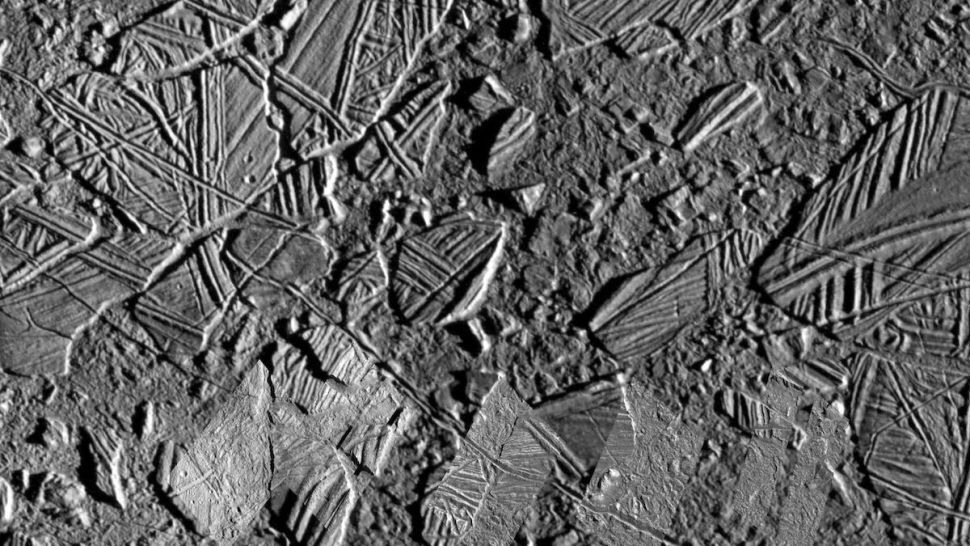26.12.2022
Planetary scientists are finding creative ways to use machine learning.

A view from the Galileo spacecraft of a "chaos" region on Jupiter's icy moon Europa. (Image credit: NASA/JPL-Caltech)
Let's be honest — it's much easier for robots to explore space than us humans. Robots don't need fresh air and water, or to lug around a bunch of food to keep themselves alive. They do, however, require humans to steer them and make decisions. Advances in machine learning technology may change that, making computers a more active collaborator in planetary science.
Last week at the 2022 American Geophysical Union (AGU) Fall Meeting, planetary scientists and astronomers discussed how new machine-learning techniques are changing the way we learn about our solar system, from planning for future mission landings on Jupiter's icy moon Europa to identifying volcanoes on tiny Mercury.
Machine learning is a way of training computers to identify patterns in data, then harness those patterns to make decisions, predictions or classifications. Another major advantage to computers — besides not requiring life-support — is their speed. For many tasks in astronomy, it can take humans months, years or even decades of effort to sift through all the necessary data.
One example is identifying boulders in pictures of other planets. For a few rocks, it's as easy as saying "Hey, there's a boulder!" but imagine doing that thousands of times over. The task would get pretty boring, and eat up a lot of scientists' valuable work time.
"You can find up to 10,000, hundreds of thousands of boulders, and it's very time consuming," Nils Prieur, a planetary scientist at Stanford University in California said during his talk at AGU. Prieur's new machine-learning algorithm can detect boulders across the whole moon in only 30 minutes. It's important to know where these large chunks of rock are to make sure new missions can land safely at their destinations. Boulders are also useful for geology, providing clues to how impacts break up the rocks around them to create craters.
Computers can identify a number of other planetary phenomena, too: explosive volcanoes on Mercury, vortexes in Jupiter's thick atmosphere and craters on the moon, to name a few.
During the conference, planetary scientist Ethan Duncan, from NASA's Goddard Space Flight Center in Maryland, demonstrated how machine learning can identify not chunks of rock, but chunks of ice on Jupiter's icy moon Europa. The so-called chaos terrain is a messy-looking swath of Europa's surface, with bright ice chunks strewn about a darker background. With its underground ocean, Europa is a prime target for astronomers interested in alien life, and mapping these ice chunks will be key to planning future missions.
Upcoming missions could also incorporate artificial intelligence as part of the team, using this tech to empower probes to make real-time responses to hazards and even land autonomously. Landing is a notorious challenge for spacecraft, and always one of the most dangerous times of a mission.
“The 'seven minutes of terror' on Mars [during descent and landing], that's something we talk about a lot,” Bethany Theiling, a planetary scientist at NASA Goddard, said during her talk. "That gets much more complicated as you get further into the solar system. We have many hours of delay in communication."
A message from a probe landing on Saturn's methane-filled moon Titanwould take a little under an hour and a half to get back to Earth. By the time humans' response arrived at its destination, the communication loop would be almost three hours long. In a situation like landing where real-time responses are needed, this kind of back-and-forth with Earth just won't cut it. Machine learning and AI could help solve this problem, according to Theiling, providing a probe with the ability to make decisions based on its observations of its surroundings.
"Scientists and engineers, we're not trying to get rid of you," Theiling said. "What we're trying to do is say, the time you get to spend with that data is going to be the most useful time we can manage." Machine learning won't replace humans, but hopefully, it can be a powerful addition to our toolkit for scientific discovery.
Quelle: SC
